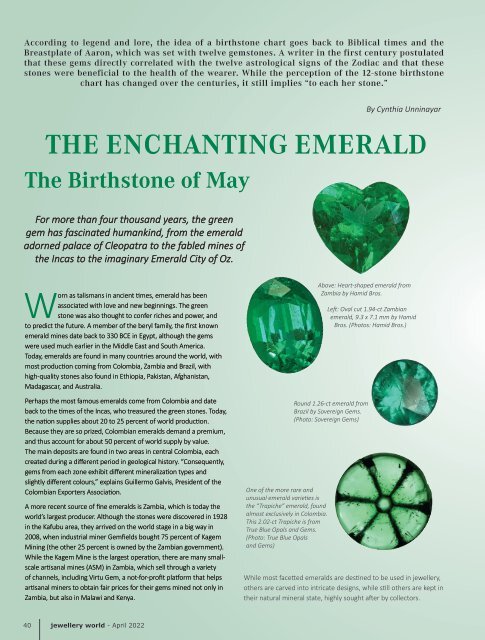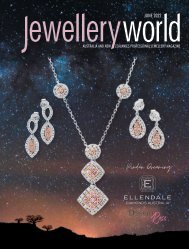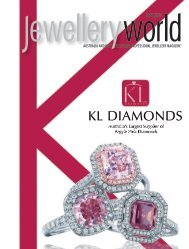Jewellery World Magazine - April 2022
Create successful ePaper yourself
Turn your PDF publications into a flip-book with our unique Google optimized e-Paper software.
According to legend and lore, the idea of a birthstone chart goes back to Biblical times and the<br />
Breastplate of Aaron, which was set with twelve gemstones. A writer in the first century postulated<br />
that these gems directly correlated with the twelve astrological signs of the Zodiac and that these<br />
stones were beneficial to the health of the wearer. While the perception of the 12-stone birthstone<br />
chart has changed over the centuries, it still implies “to each her stone.”<br />
THE ENCHANTING EMERALD<br />
The Birthstone of May<br />
For more than four thousand years, the green<br />
gem has fascinated humankind, from the emerald<br />
adorned palace of Cleopatra to the fabled mines of<br />
the Incas to the imaginary Emerald City of Oz.<br />
By Cynthia Unninayar<br />
Worn as talismans in ancient times, emerald has been<br />
associated with love and new beginnings. The green<br />
stone was also thought to confer riches and power, and<br />
to predict the future. A member of the beryl family, the first known<br />
emerald mines date back to 330 BCE in Egypt, although the gems<br />
were used much earlier in the Middle East and South America.<br />
Today, emeralds are found in many countries around the world, with<br />
most production coming from Colombia, Zambia and Brazil, with<br />
high-quality stones also found in Ethiopia, Pakistan, Afghanistan,<br />
Madagascar, and Australia.<br />
Perhaps the most famous emeralds come from Colombia and date<br />
back to the times of the Incas, who treasured the green stones. Today,<br />
the nation supplies about 20 to 25 percent of world production.<br />
Because they are so prized, Colombian emeralds demand a premium,<br />
and thus account for about 50 percent of world supply by value.<br />
The main deposits are found in two areas in central Colombia, each<br />
created during a different period in geological history. “Consequently,<br />
gems from each zone exhibit different mineralization types and<br />
slightly different colours,” explains Guillermo Galvis, President of the<br />
Colombian Exporters Association.<br />
A more recent source of fine emeralds is Zambia, which is today the<br />
world’s largest producer. Although the stones were discovered in 1928<br />
in the Kafubu area, they arrived on the world stage in a big way in<br />
2008, when industrial miner Gemfields bought 75 percent of Kagem<br />
Mining (the other 25 percent is owned by the Zambian government).<br />
While the Kagem Mine is the largest operation, there are many smallscale<br />
artisanal mines (ASM) in Zambia, which sell through a variety<br />
of channels, including Virtu Gem, a not-for-profit platform that helps<br />
artisanal miners to obtain fair prices for their gems mined not only in<br />
Zambia, but also in Malawi and Kenya.<br />
One of the more rare and<br />
unusual emerald varieties is<br />
the “Trapiche” emerald, found<br />
almost exclusively in Colombia.<br />
This 2.02-ct Trapiche is from<br />
True Blue Opals and Gems.<br />
(Photo: True Blue Opals<br />
and Gems)<br />
Above: Heart-shaped emerald from<br />
Zambia by Hamid Bros.<br />
Left: Oval cut 1.94-ct Zambian<br />
emerald, 9.3 x 7.1 mm by Hamid<br />
Bros. (Photos: Hamid Bros.)<br />
Round 1.26-ct emerald from<br />
Brazil by Sovereign Gems.<br />
(Photo: Sovereign Gems)<br />
While most facetted emeralds are destined to be used in jewellery,<br />
others are carved into intricate designs, while still others are kept in<br />
their natural mineral state, highly sought after by collectors.<br />
40<br />
jewellery world - <strong>April</strong> <strong>2022</strong>

















